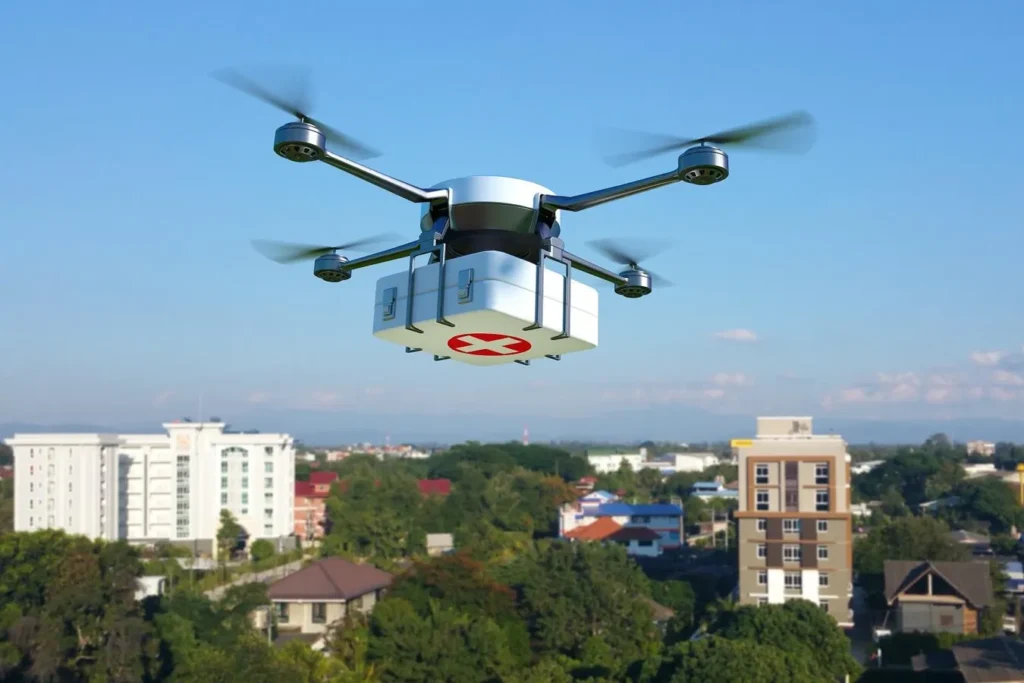Drones and robots-powered autonomous delivery services are drastically changing the way items are delivered and carried in the logistics and transportation industries. With its promises of cost-effectiveness, speed, and efficiency, this revolutionary technology represents a substantial departure from conventional distribution techniques. Last-mile delivery is about to undergo a transformation as both consumers and companies embrace automation.

The Development of Technologies for Autonomous Delivery
A variety of technologies are used in autonomous delivery services, such as ground-based robots and unmanned aerial vehicles (drones). These developments make use of developments in artificial intelligence, machine learning algorithms, sensors, and GPS navigation to enable autonomous package delivery and navigation across metropolitan environments.
Deliveries may be made much faster because to drones’ high-resolution cameras and GPS trackers, which allow them to quickly navigate around traffic and barriers. Similar to this, ground-based robots can move over sidewalks and through neighborhoods on wheels or legs, providing an alternative to conventional human-driven delivery trucks.

Benefits of Self-Driving Delivery Services
Speed and Efficiency: By avoiding traffic jams and other logistical obstacles that frequently cause delays in traditional delivery, drones and robots can deliver items quickly.
Cost-effectiveness: Automation lowers labor expenses related to hiring human drivers, which benefits both companies and customers by lowering the cost of delivery.
24/7 Operations: Autonomous systems, as opposed to human delivery workers, are able to work around the clock, guaranteeing on-time deliveries even outside of regular business hours.
Environmental Impact: Autonomous delivery services help to minimize carbon emissions and promote environmental sustainability by cutting fuel consumption and optimizing delivery routes.
Challenges and Considerations
Even with their potential advantages, autonomous delivery services encounter a number of difficulties:
Regulatory Obstacles: A lot of nations and local governments still lack precise laws pertaining to the usage of robots and drones for commercial delivery. For adoption to be widely accepted, privacy, safety, and airspace rules must be addressed.
Technological Limitations: Although advances in robotics and AI have made it possible for autonomous systems to traverse metropolitan environments, obstacles like bad weather, uneven terrain, and possible technical malfunctions still exist.
Public Perception: Consumers’ acceptance of autonomous delivery systems varies, with worries about security, privacy, and job displacement frequently mentioned as adoption hurdles.
Utilizations in All Sectors
Numerous sectors have already used autonomous delivery services:
Retail: To improve consumer satisfaction and retention, e-commerce behemoths and merchants deploy robots and drones to quickly fulfill online orders.
Food and Beverage: To ensure that consumers receive hot, fresh food promptly, restaurants and food delivery services use robots and drones to serve meals.
Healthcare: By making it easier to move vaccines, medical supplies, and sample between facilities, autonomous delivery services enhance patient care efficiency.
Urban Logistics: To ease traffic congestion, cut pollution, and improve urban logistics networks, cities are looking at using autonomous delivery systems.
Prospects for the Future
Autonomous delivery services are expected to see sustained expansion and innovation in the future.
Technological Advancements: Research and development efforts are concentrated on expanding the capabilities of robots and drones, with the aim of improving their obstacle avoidance systems, extending their flying periods, and carrying heavier loads.
Integration with AI: Real-time route optimization, experience-based learning, and adaptability to changing circumstances are all made possible by the development of artificial intelligence.
Collaboration: To enable the widespread adoption of autonomous delivery services, industry stakeholders—including technology companies, regulators, and urban planners—are working together to set standards, policies, and infrastructure.
In summary
The logistics and transportation sector is undergoing a revolutionary change with autonomous delivery systems, which provide unmatched speed, efficiency, and cost-effectiveness. The potential advantages of drones and robots in delivery are evident, even though there are still obstacles to overcome, such as regulatory frameworks and public acceptability. The future of logistics is about to be redefined by autonomous delivery services, which will shape a more sustainable and effective global supply chain as technology advances and acceptance rises.
Adopting these breakthroughs necessitates a measured strategy that addresses privacy, safety, and ethical issues while maximizing the potential of autonomous delivery technologies to satisfy the expanding demands of the digital economy.
